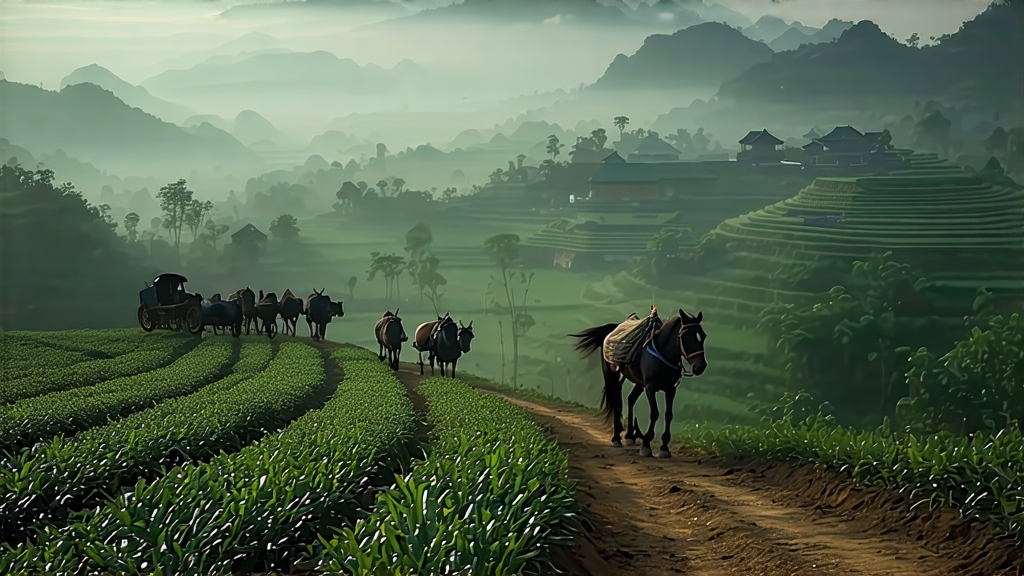
Tucked away in the humid, karst-pocked southwest of China, the small town of Liubao has been quietly exporting history one cup at a time since the Qing dynasty. Liubao tea, a sub-category of Chinese dark tea (hei cha), is still produced along the winding Liu River in Guangxi Province using methods that would be recognizable to the horsemen who once carried it along the Ancient Tea Road to Southeast Asia. For international drinkers accustomed to the peaty smoke of Lapsang or the muscatel of Darjeeling, Liubao offers a different compass point on the flavor map: forest floor, licorice root, and a faint echo of betel nut that lingers like incense in a temple courtyard.
Historical footprints
The earliest written record appears in the 1862 edition of Cangwu County Annals: “Tea from Liubao, cool in nature, clears heat and relieves malaria; merchants buy it in spring and ship it to Guangzhou.” By the late 17th century, bamboo-leaf-wrapped baskets of Liubao were moving down the Xi River to the port of Guangzhou, then onward to Hong Kong, Malaya, and Indonesia where tin-mine coolies swore by its ability to ward off dampness and fever. In 1886, the British colonial government listed “Liu-Pao” among taxable imports in the Straits Settlements, proof that the tea had already sailed beyond the Chinese diaspora. After the opening of the Yunnan–Vietnam railway in 1910, Liubao even reached France, where Parisian cafés served it as “thé noir de Chine” alongside madeleines—an early east-meets-west pairing that predates the modern tea-latte craze by a century.
From leaf to dark gold
Liubao starts life as a leafy cultivar called “Yunnan large-leaf” transplanted to Guangxi’s red lateritic soil. Picking occurs from April to September; the standard is one bud with three or four leaves, tougher material than the tender tips used for green tea. After wilting under mountain shade, the leaves are wok-fired at 200 °C for eight minutes to kill green enzymes, then rolled into thick cords that can withstand the humid fermentations ahead.
What distinguishes Liubao from other dark teas is its “wet piling” (wo dui) conducted in an above-ground wooden shed rather than the cement-floor pools of Yunnan shou pu-erh. Workers build 80-kilogram heaps, spray them with misty river water, and cover them with jute sacks and rice straw. Inside the pile, temperatures climb to 55 °C within 36 hours, activating a microbial consortia dominated by Aspergillus niger, Blastobotrys adeninivorans, and a lactic-acid bacterium unique to Liubao, Lactobacillus liubaoensis sp. nov. Every three days the pile is turned by hand, allowing oxygen to moderate the fermentation and prevent anaerobic spoilage. After 25–30 days the leaves have turned chestnut-brown and exude a sweet, almost soy-sauce-like aroma.
The final steps are sun-drying on bamboo racks, then a slow charcoal bake at 45 °C for six hours to fix the flavor. Some lots are pressed into 500 g baskets woven from bamboo strips; others are left loose and stored in clay jars whose micro-pores swap air with the tea, polishing rough edges over decades. A well-aged Liubao from the 1980s can fetch USD 800 per 100 g at auction in Kuala Lumpur, rivaling vintage pu-erh.
Tasting time
To unlock Liubao’s layered personality, use a 150 ml Yixing teapot or a gaiwan. Rinse 6 g of leaf with 95 °C water for five seconds and discard—this wakes up dormant aromatics. The first proper infusion, 15 seconds, pours out the color of black cherry with a rim of amber. Bring the cup to your nose: humid bark, star anise, and a whiff of camphor that evokes an old Chinese medicine chest. Sip; the liquor is silky, slightly tannic, with a cooling menthol finish that Chinese drinkers call “ginger spiciness at the throat.”
Subsequent steeps lengthen by five seconds each, revealing a rotation of flavors: dark honey, dried longan, then a mineral note reminiscent of wet slate. By the sixth infusion the color pales to rosé, yet a sweet